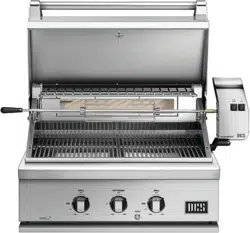Loading ...
Loading ...
Loading ...

8
(7,6cm)
(7,6cm)
(61,6cm)
(5,5cm)
2-3/16”
22-5/16”
(56,7cm)
(64,77cm)
(26,67cm)
(25,4cm)
26-5/8”
(67,6cm)
/ 99,06cm
FIG. 02
INSTALLATION
LOCATING GRILL/BUILTIN CLEARANCES
(BH1-30R illustrated)
Clearances to Non-Combustible Construction*
Clearances to Combustible Construction**:
Minimum of 18” /45,7cm from the sides and rear of grill must be maintained to adjacent vertical combustible con-
struction, above the counter top level. You should take in account that there is a large volume of heat, and smoke
will exhaust from the rear of the grill. This may discolor or damage unprotected areas (Fig. 03). Do not install
under unprotected combustible construction without using a fire safe ventilation system.
A 18” /45,7cm minimum clearance must be maintained under the counter top to combustible construction. The
clearance can be modified by a use of an insulated jacket.
Clearances to Non-Combustible Construction*:
A minimum of 3” / 7,6cm clearance from the back of the grill to non-combustible construction is required for the
purpose of allowing the lid to open fully. It is desirable to allow at least 6” / 15,2cm rear and side clearance to
non-combustible construction above the cooking surface for counter space. If you’ll be using the rotisserie option
(BGC30-BQR models only), the space is essential for motor and skewer clearance. The grill can be placed directly
adjacent to non-combustible construction below the cooking surface. (Fig. 02).
WARNING!
Failure to maintain required clearances creates a fire hazard that may result in property damage or serious personal
injury.
WARNING!
The BGC/BH1 Grills are designed to function in an open area. Recommended minimum clearances should be main-
tained to all surfaces (combustible and noncombustible) for optimum performance. Noncombustible material within
the minimum clearance area could result in discoloration or deterioration.
WARNING!
If a noncombustible material such as stucco is covering a combustible material such as wood, the minimum clear-
ance distance needs to be held to the wood. The presence of a noncombustible material inside the clearance zone
does not eliminate the minimum clearance zone to combustible material.
* DEFINITION OF NONCOMBUSTIBLE MATERIAL - Material which is not capable of being ignited and burned, such as
materials consisting entirely of, or a combination of, steel, iron, brick tile, concrete, slate, and plaster.
Loading ...
Loading ...
Loading ...
